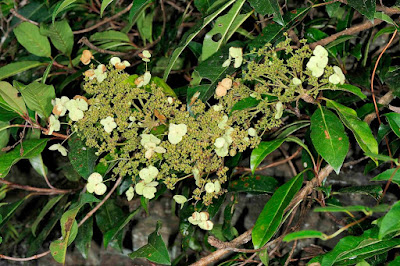Hydrangea integrifolia is native to Taiwan and the Philippines. It grow in dense forests on rocky mountain slopes at elevations of 1000-2800 meters above sea level.
Hydrangea integrifolia also called as Entire leaf hydrangea, is a species of the genus Hydrangea. This species was described by Bunzo Hayata in 1906.
IDENTIFY HYDRANGEA INTEGRIFOLIA PLANT
Hydrangea integrifolia is native to Taiwan and the Philippines. It grow in dense forests on rocky mountain slopes at elevations of 1000-2800 meters above sea level.
It is a shrubs climbing with brown-red, subglabrous branchlets and subglabrous petiole that has elliptic, oblong-elliptic, or obovate, 7-22 × 3.5-8 cm, leathery leaves with both surfaces glabrous, secondary veins 7-10 on both sides of midvein, curved, abaxially prominent, base subacute to cuneate, margin slightly reflexed, entire, apex acuminate.
Entire leaf hydrangea may take 5 to 7 years to reach maturity and begin blooming in July from the terminal, corymbose cymes inflorescence that are 8-10 cm wide, to 17 cm wide in fruit, apex subtruncate; peduncle and branches densely yellow-brown stellate hairy and pilose; branches crowded together at apex of peduncle. The sterile flowers with 2-4 sepals, suborbicular to broadly orbicular, 1-1.5 × 0.8-2 cm, margin entire to sinuate. The fertile flowers with calyx tube cupular, ca. 1 mm; teeth 4 or 5, broadly ovate, less than 1 mm. Petals oblong, 2.5 mm.
The key to identify this species is: ovary completely inferior; capsule apex truncate; petals free; seeds winged at both ends; leaf blade margin entire; bracts closely enveloping inflorescence in bud, ovate-orbicular; vines climbing.
HYDRANGEA INTEGRIFOLIA PLANT CARE AND CULTURE
Cultural information should only be used as a guide, and should be to be adapted to suit you. Your physical location; where you grow your plants, how much time you have to devote to their care, and many other factors, will need to be taken into account. Only then can you decide on the cultural methods that best suit you and your plants.
Light:
Hydrangea integrifolia love the warm morning sun, but they dislike the heat of the afternoon (can grow in full sun with adequate soil moisture). The best place to plant this species is in a sheltered location with sunny mornings and shady afternoons. Avoid planting directly underneath trees, which can lead to competition for water and nutrients. Although they can be successfully grown in full shade, they will not bloom well.
Temperature:
Keep the plants in a cool location, from 18° to 24°C. This plant grow well and are reliably winter hardy. Cold winters and late spring frosts can often kill flower buds, preventing plants from blooming in the spring.
Substrate, growing media:
Hydrangea integrifolia are best planted in soil that has been amended with adequate amounts of organic matter, such as compost, leaf mold, or well-composted manure. While most hydrangeas grow better in soil that is lower in pH (acidic), they will tolerate higher pH soils (alkaline) quite well.
Watering and humidity:
Entire leaf hydrangea prefer consistent moisture but dislike wet feet. Mulch to help conserve moisture and cool the root system. A two- to three-inch layer of mulch will help to conserve moisture.
Fertilizer:
Fertilizing is generally not recommended unless a nutrient deficiency is observed. This plants may need little fertilizer in rich soil with organic matter applied yearly. Avoid using too much nitrogen - this can encourage foliage growth at the expense of blooms.
Pruning:
Hydrangea integrifolia can be left unpruned and only blackened winter-injured tips removed in the spring. Pruning is only necessary for aesthetics and is typically limited to minor training of growth and deadheading. Dead or diseased branches can be pruned out at any time of the year.















COMMENTS